1998 PONTIAC GRAND PRIX steering wheel
[x] Cancel search: steering wheelPage 207 of 402
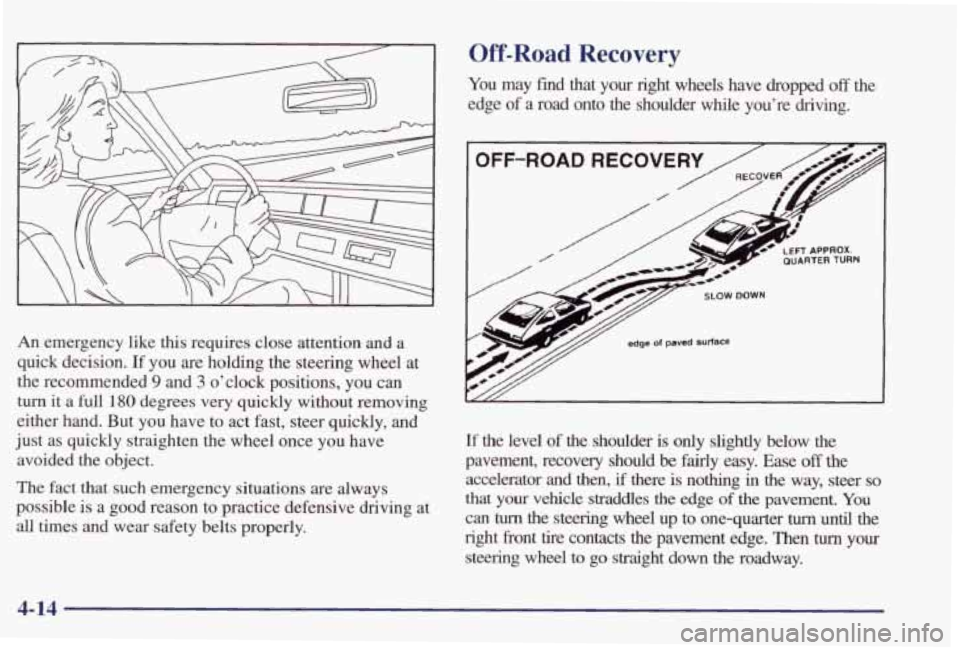
An emergency like this requires close attention and a
quick decision.
If you are holding the steering wheel at
the recommended
9 and 3 o’clock positions, you can
turn it a full 180 degrees very quickly without removing
either hand. But you have to act fast, steer
quickly, and
just as quickly straighten the wheel once you have
avoided the object.
The fact that such emergency situations are always
possible is a good reason to practice defensive driving at
all times and
wear safety belts properly.
Off-Road Recovery
You may find that your right wheels have dropped off the
edge
of a road onto the shoulder while you’re driving.
LEFT APPROX. WARTER TURN
edge of pamd wrfsco
If the level of the shoulder is only slightly below the
pavement, recovery should
be fairly easy. Ease off the
accelerator and then, if there is nothing in the way, steer so
that your vehicle straddles the edge of the pavement. You
can turn the steering wheel up to one-quarter turn until the
right front tire contacts the pavement edge. Then turn your
steering wheel to go straight down the roadway.
4-14
Page 209 of 402
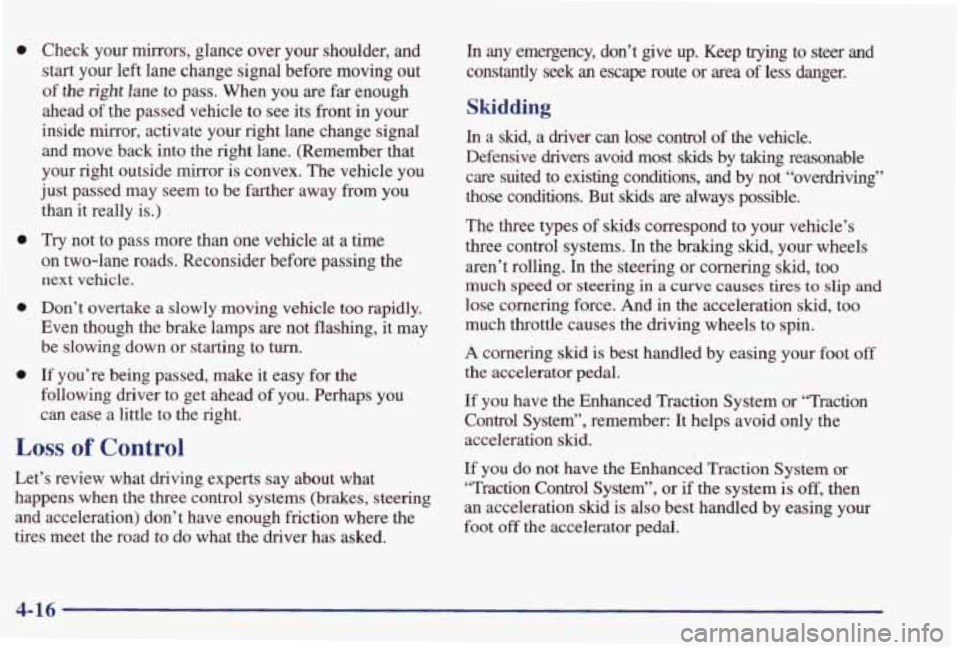
0
0
0
0
Check your mirrors, glance over your shoulder, and
start your left lane change signal before moving out
of the right lane to pass. When you are far enough
ahead
of the passed vehicle to see its front in your
inside mirror, activate your right lane change signal and move back into the right lane. (Remember that
your right outside mirror
is convex. The vehicle you
just passed may seem to be farther away from you
than it really is.)
Try not to pass more than one vehicle at a time
on two-lane roads. Reconsider before passing the
next vehicle.
Don’t overtake a slowly moving vehicle too rapidly.
Even though the brake lamps are not flashing,
it may
be slowing down or starting to turn.
If you’re being passed, make it easy for the
following driver to get ahead of
you. Perhaps you
can ease a little to the right.
Loss of Control
Let’s review what driving experts say about what happens when the three control systems (brakes, steering
and acceleration) don’t have enough friction where the
tires meet the road to
do what the driver has asked.
In any emergency, don’t give up. Keep trying to steer and
constantly
seek an escape route or area of less danger.
Skidding
In a skid, a driver can lose control of the vehicle.
Defensive drivers avoid most skids
by taking reasonable
care suited to existing conditions, and
by not “overdriving”
those conditions. But skids are always possible.
The three types
of skids correspond to your vehicle’s
three control systems. In the braking skid, your wheels
aren’t rolling.
In the steering or cornering skid, too
much
speed or steering in a curve causes tires to slip and
lose cornering force. And in the acceleration skid, too
much throttle causes the driving wheels to spin.
A cornering skid is best handled by easing your foot off
the accelerator pedal.
If you have the Enhanced Traction System or ‘Traction
Control System”, remember: It helps avoid only the acceleration
skid.
If you do not have the Enhanced Traction System or
‘Traction Control System”, or
if the system is off, then
an acceleration skid is also best handled by easing your
foot
off the accelerator pedal.
4-16
Page 230 of 402
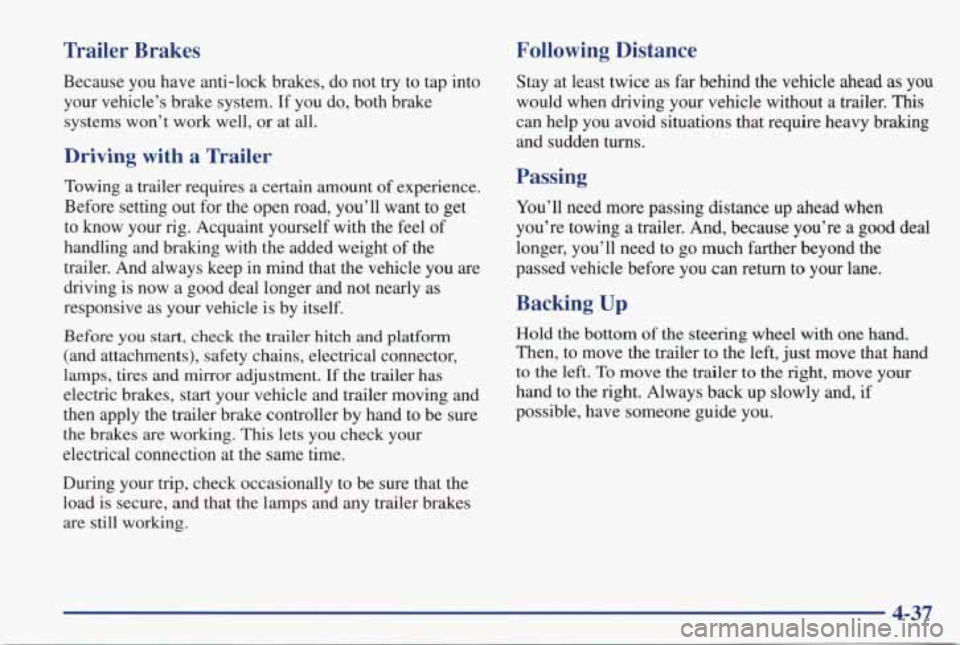
Trailer Brakes Following Distance
Because you have anti-lock brakes, do not try to
tap into
your vehicle’s brake system.
If you do, both brake
systems won’t work well,
or at all.
Driving with a Trailer
Towing a trailer requires a certain amount of experience.
Before setting
out for the open road, you’ll want to get
to know your rig. Acquaint yourself with the feel of
handling and braking with the added weight
of the
trailer. And always keep in mind that the vehicle you are
driving is now
a good deal longer and not nearly as
responsive as your vehicle is by itself.
Before
you start, check the trailer hitch and platform
(and attachments), safety chains, electrical connector,
lamps, tires and
mirror adjustment. If the trailer has
electric brakes, start your vehicle and trailer moving and
then apply the trailer brake controller by hand to be sure
the brakes
are working. This lets you check your
electrical connection at the same time.
During your trip, check occasionally to be sure that the
load is secure, and that the lamps and any trailer brakes
are still working. Stay at least twice
as far behind the vehicle ahead
as you
would when driving your vehicle without a trailer. This
can help you avoid situations that require heavy braking
and sudden turns.
Passing
You’ll need more passing distance up ahead when
you’re towing a trailer. And, because you’re a good deal \
longer, you’ll need to go much farther beyond the
passed vehicle before you can return to your lane.
Backing Up
Hold the bottom of the steering wheel with one hand.
Then, to move the trailer
to the left, just move that hand
to the left. To move the trailer to the right, move your
hand to the right. Always back up slowly and,
if
possible, have someone guide you.
4-37
Page 245 of 402
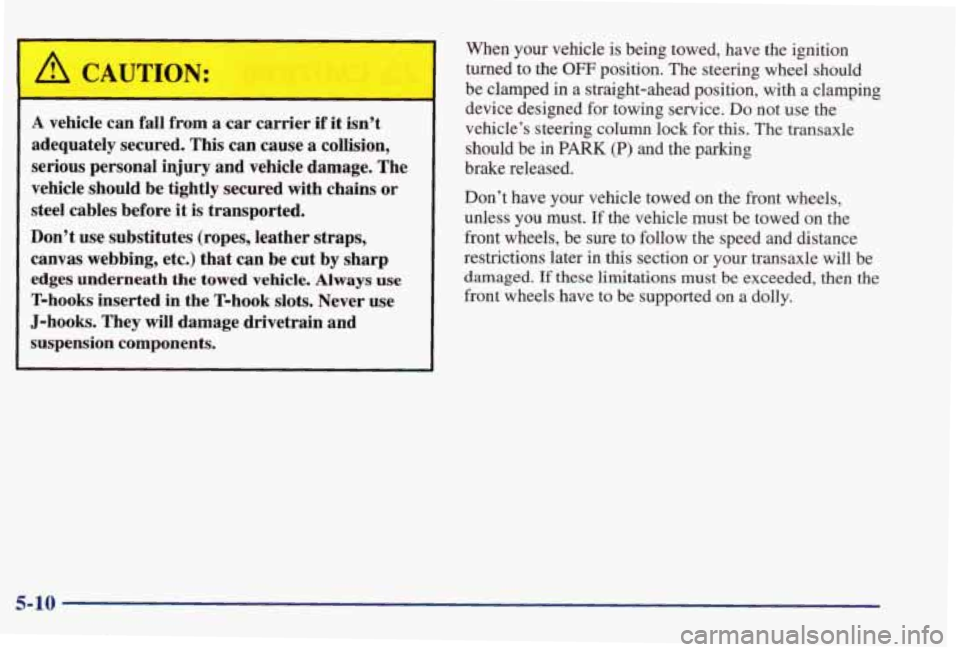
A CAUTION:
A vehicle can fall from a car carrier if it isn’t
adequately secured. This can cause a collision,
serious personal injury and vehicle damage. The
vehicle should be tightly secured with chains
or
steel cables before it is transported.
Don’t use substitutes (ropes, leather straps,
canvas webbing, etc.) that can be cut by sharp
edges underneath
the towed vehicle. Always use
T-hooks inserted in the T-hook slots. Never use
J-hooks. They will damage drivetrain and
suspension components.
When your vehicle is being towed, have the ignition
turned
to the OFF position. The steering wheel should
be clamped
in a straight-ahead position, with a clamping
device designed for towing service.
Do not use the
vehicle’s steering column lock for this. The transaxle
should be
in PARK (P) and the parking
brake released.
Don’t have
your vehicle towed on the front wheels,
unless you must. If the vehicle must be towed on the
front wheels, be sure to follow the speed and distance
restrictions later
in this section or your transaxle will be
damaged. If these limitations must be exceeded, then the
front wheels have to be supported on a dolly.
5-10
Page 261 of 402
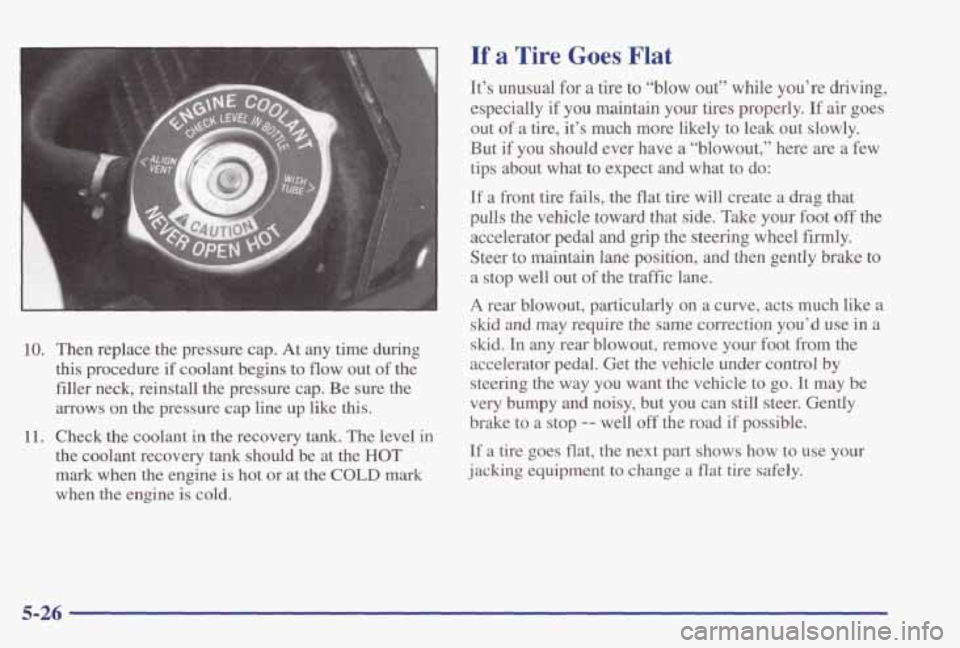
10. Then replace the pressure cap. At any time during
this procedure if coolant begins to flow out of the
filler neck, reinstall the pressure cap. Be sure the
arrows on the pressure cap line up like this.
11. Check the coolant in the recovery tank. The level in
the coolant recovery tank should be at the
HOT
mark when the engine is hot or at the COLD mark
when the engine
is cold.
If a Tire Goes Flat
It’s unusual for a tire to “blow out” while you’re driving,
especially if
you maintain your tires properly. If air goes
out
of a tire, it’s much more likely to leak out slowly.
But if
you should ever have a “blowout,” here are a few
tips about what to expect and what to do:
If a front tire fails, the flat tire will create a drag that
pulls the vehicle toward that side. Take your foot
off the
accelerator pedal
and grip the steering wheel firmly.
Steer to maintain lane position,
and then gently brake to
a stop well out of the tr&k lane.
A rear blowout, particularly on a curve, acts much like a
skid and may require the same correction you’d use in a
skid. In any rear blowout, remove your foot from the
accelerator pedal. Get
the vehicle under control by
steering the way you want the vehicle to
go. It may be
very bumpy and noisy, but you can still steer. Gently
brake to a stop
-- well off the road if possible.
If a tire goes flat, the next part shows how to use your
jacking equipment
to change a flat tire safely.
5-26
Page 274 of 402
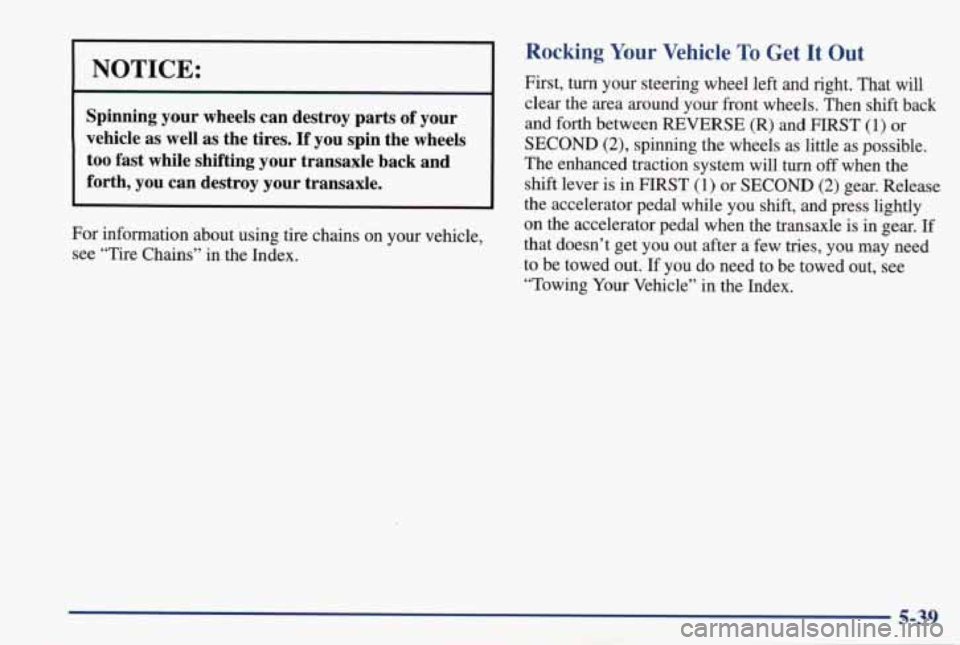
Rocking Your Vehicle To Get It Out
clear the area around your front wheels. Then shift back
NOTICE:
I First, turn your steering wheel left and right. That will
Spinning your wheels can destroy parts of your
shift lever is in FIRST (1) or SECOND (2) gear. Release forth, you can destroy your transaxle.
The enhanced traction system will turn off when the too fast while shifting your transaxle back and
SECOND (2), spinning the wheels as little as possible. vehicle as well as the tires. If you spin the wheels
and forth between REVERSE (R) and FIRST (1) or
the accelerator pedal while you shift, and press lightly
on the accelerator pedal when the transaxle
is in gear. If
For information about using tire chains on your vehicle, that doesn’t get you out after a few tries, you may need
see
“Tire Chains” in the Index. to be towed out. If you do need to be towed out, see
“Towing Your Vehicle” in the Index.
Page 339 of 402

FUSE USAGE CHART I See Underhood Electrical
Center For Spare Fuses I I I I
CIRCUIT BREAKERS
I HEADLAMP I
I I MAUPGM
STR WHL STR WHL
CTRL
I
I I PWR LOCK I I
RAP HAZARD ~
GIG LTR
I/P - IGN
CRUISE
ECM STOP LAMP
INT LAMP
ABS
PWR DROP MALL
WIPER
SUNROOF
CD CHG
AUWCNSL HVAC
HI PWR MIR
R DEFOG
HSEATILUM
RADIO
SIR TURN
BTSl
HVAC CTRL DlCRlVAC
I I I I CANISTER DRL VENT
rinted in USA.
For More Information, See Owner’s Manual 10401979)
Description
Circuit
Breaker
HEADLAMP
Headlamps
SEAT Power Seat, Power Lumbar
PWR WDO Power Windows
Fuse Description
MALL PGM Mall Module -- Program
MALL Mall Module
Fuse
WIPER
STR WHL
STR WHL
CTRL
SUNROOF
RADIO
PWR LOCK
HSEATLUM
R DEFOG
RAP
HAZARD
PWR MIR HVAC
HI
CIG LTR
INT LAMP STOP LAMP
Description
Wipers
Steering Wheel Illumination
Steering Wheel Control
Sunroof
Radio, Antenna
Mall Module
-- Power Locks
Heated Seats, Power Lumbar
Rear Defog
Retained Accessory Power, Mall Module
Hazard Flashers
Power Mirrors
HVAC Blower -- Hi
Cigarette Lighter,
ALDL, Floor
Console Auxiliary Outlet
Mall Module
-- Interior lamps
S toplamp
6-64
Page 382 of 402

Section 9 Index
Accessory Power outlet ......................... 2-58
Adding Equipment to the outside of Your Vehicle ...... 6-3
AirBag ....................................... 1-23
How it Works ................................ 1-24
Readiness Light ......................... 1.23. 2.67
Air Cleaner .................................... 6-20
Air Conditioning ............................ 3.3. 3.7
Air Conditioning Refrigerants ..................... 6-70
Alignment and Balance. Tire ...................... 6-50
Aluminum Wheels. Cleaning ...................... 6-57
Anti-Lock
Brake System Warning Light
................ 2.67. 4.9
Brakes ...................................... 4-7
Anti.Theft. Radio .............................. 3-27
Appearance Care ............................... 6-52
Appearance Care Materials Chart .................. 6-60
ArbitrationPro gram .............................. 8-9
Arming Confirmation ............................. 2-15
Arming with the Power Lock Switch ................ 2-14
Ashtrays and Lighter ............................ 2-57
Audio Controls. Steering Wheel ................... 3-29
Audio Equipment. Adding ........................ 3-30
Audio Systems ................................. 3-10
Arming with the Remote Keyless Entry Transmitter .... 2-15
Automatic
Auxiliary Temp Control
....................... 3-4
Doorhcks .............................. 2.6. 2.47
Check ...................................... 7-15
Fluid ....................................... 6-22
Operation ................................... 2-21
Park Mechanism Check ....................... 7-17
Backglass Antenna ............................. 3-21
With a Trailer ................................ 4.37
Battery ....................................... 6-36
Jump Starting ................................. 5-3
Replacement, Remote Keyless Entry .............. 2-10
Resynchronizing, Remote Keyless Entry ........... 2-11
Warnings ........................... 5-3,5-5, 6-37
Battery Replacement ............................ 2-10
BatterySaver .................................. 2-43
BBB Auto Line ................................. 8-9
Before leaving on a Long Trip ..................... 4-24
Better Business Bureau Mediation ......... ..... 8-9
Blizzard ............................. .... 4-29
9-1